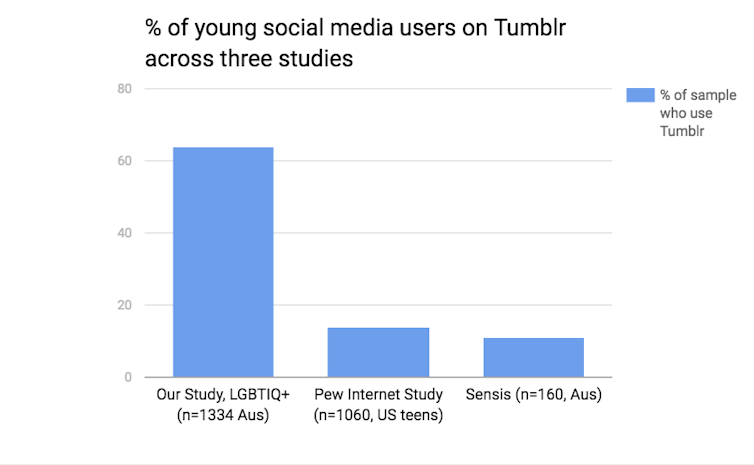Tumblr is a site that can leave many adults confused. But for more than 330 million users worldwide it is a visual medium for self-expression where anything from politics to fan groups goes.
What makes Tumblr special is the mix of content you will find there. Think of it as the long-form, image-centric version of Twitter – but more personal. A blog can feature sentences that describe a user’s day, and this could be scattered among photo sets of refugees being rescued at sea, cat gifs, pornography, or complex paragraphs that analyse Donald Trump’s presidency. Above all, Tumblr characterises itself as a space of creative freedom.
Like most other social media platforms, it is also ripe with peer networking, community building, and opportunities to explore gender and sexual identities. And despite the panic that often surrounds the perceived effects of social media on young people – such as fears about Facebook and privacy, Snapchat and sexting, and Instagram and narcissism – Tumblr is often left out of the debate.
Perhaps that’s because it mostly appeals to a niche audience, and can be seen as the “weird” cousin of these major platforms. This makes it a perfect venue for queer and questioning youth to hang out.
It’s a queer world
In 2016, we organised a research project called Scrolling Beyond Binaries to explore the ways young people of diverse genders and sexualities use social media. We looked particularly at how young lesbian, gay, bisexual, transgender, intersex, queer, and asexual (LGBTIQA+) people use the network. To do so, we surveyed over 1,300 people aged 16-35 who identified in these ways.
Compared to broader surveys of young people’s social media use, we found young LGBTIQA+ people are using Tumblr much more frequently.

There are some issues in comparing these studies – the number of people surveyed, where they lived, and their ages – but that 64% of our respondents used Tumblr is noteworthy.
So why are this many young queer and gender diverse Australians using Tumblr? For many, it offers an intricate network that supports safe explorations of identity and a sense of self.
For instance, writer and Tumblr user Jonno Revanche said it provides social connections that are otherwise unavailable due to geographic isolation and social anxiety. Others have used Tumblr to foster mental health support, such as Mea Pearson, who took to the platform to chronicle her experience with borderline personality disorder.
While care must be taken when associating mental health with queer identity, these matters often intersect. Evidently, many young people’s everyday dealings with key social institutions like family, work and school can be uncomfortable or even traumatic.
The view from Tumblr
Many of our respondents said that Tumblr was crucial to nurturing their individual identity. One person said it helped them identify as agender (loosely defined as without gender).
I actually learnt about agender and all the other genders from Tumblr. (20, agender, bisexual, rural)
One participant described how Tumblr assisted them in coming to terms with their pansexuality (attraction to all genders), and finding a space where this was more accepted and not reduced to bisexuality:
I came out as Pan on Tumblr a few years ago, when being Pan was seen as just a fancy way of saying Bi. I felt very alone for a long time, but found other Pan people to talk to. (22, non-binary, pansexual, urban)
Other participants attributed Tumblr to broadening their overall understanding of identity:
I had no idea that lgbt+ people existed (my parents are quite homophobic and very strict, so you could say I was very sheltered), and by using Tumblr I was able to fully immerse myself within its very lgbt+ culture. It also brought up words … I had never heard before, and through this I was able to “find myself” within a safe environment. (17, female, lesbian, urban)
I would’ve never realised my real gender or sexual orientation without tumblr. (25, trans masculine, asexual, regional)
For many Tumblr users, the platform is a supportive place. Engaging with online peer networks can be easier, and less risky, than talking to close friends. Young people reported making friends on Tumblr too, and most of them felt safe in doing so, citing the ability to block and unfollow others if needed.
I’ve made a lot of friends through there, and Tumblr helped me working out my own sexuality when I was younger. Because when I was younger I didn’t know anything, I thought there was just gay and lesbian and when I didn’t fit into any of those categories I was like “what the hell do I do now.” It was honestly, like going on Tumblr and [finding] there’s this thing where you can like more then one, I was like “woah, that’s amazing.” (19, trans male, queer, urban)
Disconnecting from Tumblr
At the same time, these digital spaces come with their own challenges. Although Tumblr is often used daily, it also seems to have a limited lifespan – which is unsurprising, given the intensity of interaction and content that many users report. Some respondents discussed their need to disconnect from the site to avoid drama, to free up time, or to spend more time in other social media spaces.
I stopped [using Tumblr] because I often used it to talk about my problems and it got to be really upsetting to have such a negative space. I feel like it just fed my mental health issues. (18, non-binary, bisexual, rural)
In this sense, Tumblr can be productive for a time but it can also become overwhelming. Users manage this by moving between platforms and taking breaks.
Safe spaces
At a time when young queer and gender diverse people are in the spotlight, with support programs coming under fire and human rights being trampled upon in political crossfires, they continue to find and build their own safe spaces.
LGBTIQA+ young people should feel safe and empowered in everyday physical spaces, and many do – often with support from a wider community of peers who share similar experiences.
But until the world becomes more friendly for queer and gender diverse people, we expect they’ll continue to find safety, community, identity, and friendship on Tumblr.

